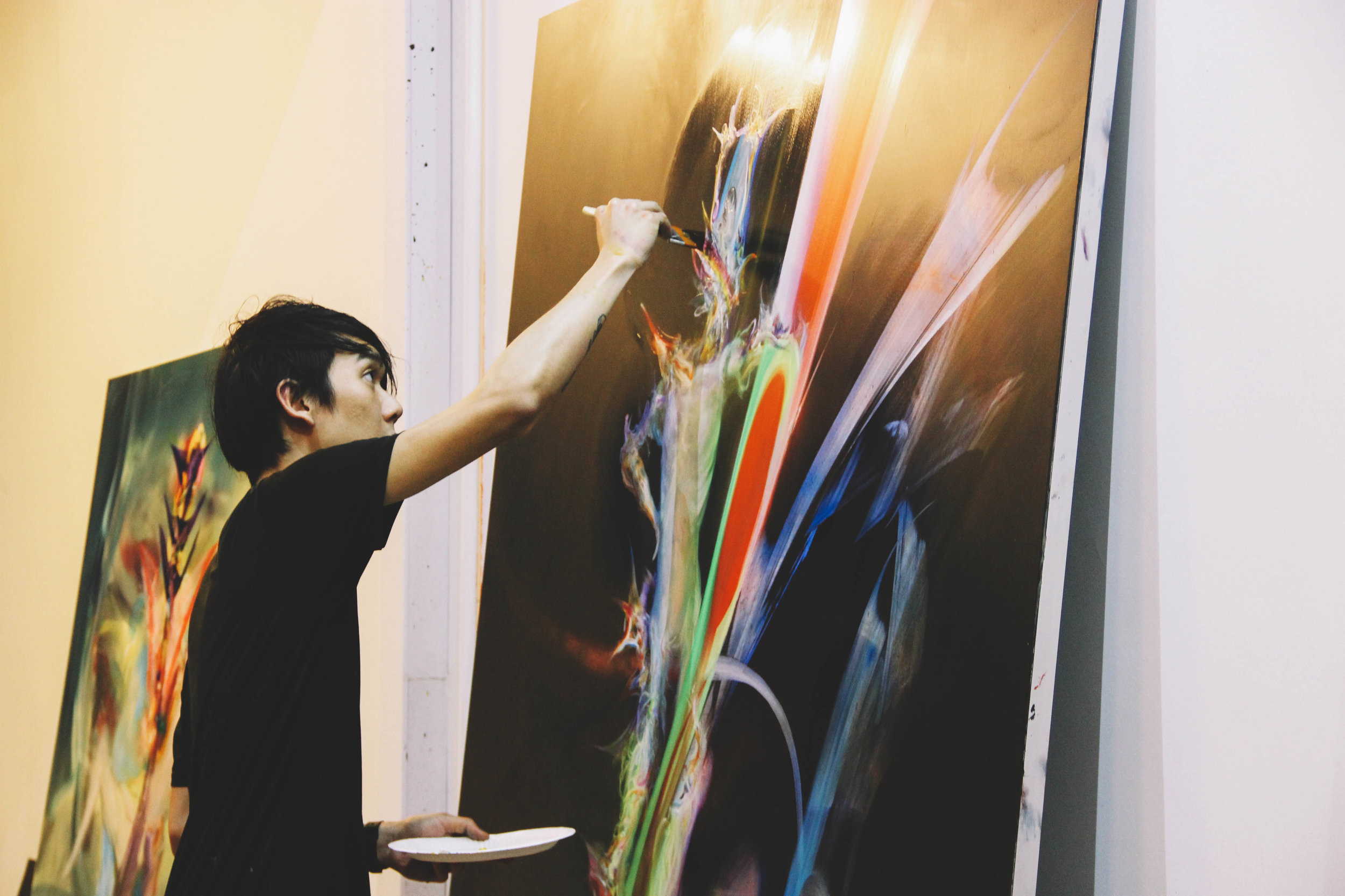A collection of conversations with a diverse range of local and regional creatives
Library Conversations for SGABF2020
We examined the systems that support art book making and independent art book publishing in Singapore and the region.
A Closer Look for SGABF2019
We gathered perspectives on our zine and art book culture, and discuss the possibilities of self-publishing today.
21 Creatives for SGABF2018
We sat down with 21 creatives of various disciplines to learn about their practice and asked each of them to fill up a blank page in a notebook.
SGABF: You choose to paint on aluminium because of how the oil you use makes your art unpredictable. In your artist statement, you had also attributed creation to chance, seeing it as an essential factor in your work. In that way, you make yourself vulnerable to different possibilities as well. Would you say that your works are experimentations and introspective explorations in a way?
Ruben Pang (RP): My belief is that you go to school to learn art theory and things to back yourself up. I assume this is what people look for. But I have met awesome curators who would tell me, “You don’t have to know what you are doing.” I suspect they are spies. [laughs] But I can see that it comes from the heart and it is comforting when someone in that position tells you that.
I do brush things aside, I pretend not to care about spirituality, to be a cynic and pretend it is all an accident. The fact is that as much as I pretend that I am not affected by what people say, I am. But I do not want to roleplay a character that I am not. When I do something that I really like, I am vulnerable. Many of us understand that in principle, but the body does not catch up. So I am choosing to be humble and thankful.
In music, I like to improvise because that is where the magic happens. You learn your skills first, like memorising the fretboard and the drumbeat, then you find people who do the same thing. There are times when you are creating in the studio before the audience arrives – depending on the stars and the moon – and magic happens. There is something beautiful about that chaos. The chaos that is in sync at the right time, the counterpoint, the connected minds, the telepathy…
In painting, it is all you, and all ego. But we are multidimensional; you can come back to your painting another day as a different person. Maybe you cover a bunch of layers with a volatile-ish medium, and you think you messed it up, so you sand it away. Then you see that two layers down, you painted something that worked that you did not see, and it works with the layer that you are putting down now. There are no bandmates to go, “Did you fucking see that?” But I like those sorts of accidents.
SGABF: As an artist, how do you know when a piece is truly completed?
RP: Sometimes, I feel like gagging when I look at some of my works. I associate it with this closed, stuck, dark feeling, which is very different from egotistically feeling like I have improved and therefore I distance myself from the art piece.
It is a feeling when you haven't come to terms with the fact that you looked at your work with the same pair of eyes but did not see something. I think that is what a lot of artists go through, writers included. They would look at their own works and all they see are the parts that they should edit.With that in mind, I know that there are parts that I definitely want to change, but there are also times where I would go, "That’s pretty good, how did I do that?" That is what I look for.

There is also that sensation of instinct, of something opening up; satisfaction. I try not to make satisfaction such a big deal, and I ignore it because what gives you satisfaction will change over time. So if I feel something behind my sternum and ribcage and it feels like opening up, and intellectually when it is quiet and you are not putting too much thought into it, when the voices of how you are going to spin the narratives go away, and there is not too much judgement and opinion, that is when you know it is done. Sometimes you might not know, so you use maps. You compare to your heroes or your sketches - things that help to guide yourself through painting. I'd like to think I don't need that and I can just create in the dark, like in the biblical story; first, everything was created, then [God] turns on the light.
What I do not like about painting is the slowness. I wish it could be as quick as thought, just bang, bang, bang! and you get the colours. But sometimes that is where you get the satisfaction — as much as I do not like the idea of satisfaction. It is this feeling you get that you earned every bit of it; you spent time. I like to think that I pull ideas out of thin air, but I actually spend a lot more time thinking up ideas about what to do, and less time conceptualising. That is done when you are not really thinking about it.
RP: I think these days less so than throughout the course of art history. There are some things that you do not get to do that you probably could get away with in the past, like manifestos where you generalise the population of a world that you have never seen before and assume that you are the first to do it. Now, you have access to more information about what is going on and where, and people are more self-conscious. There is a hyperconsciousness of what else is going on in the postmodern world.
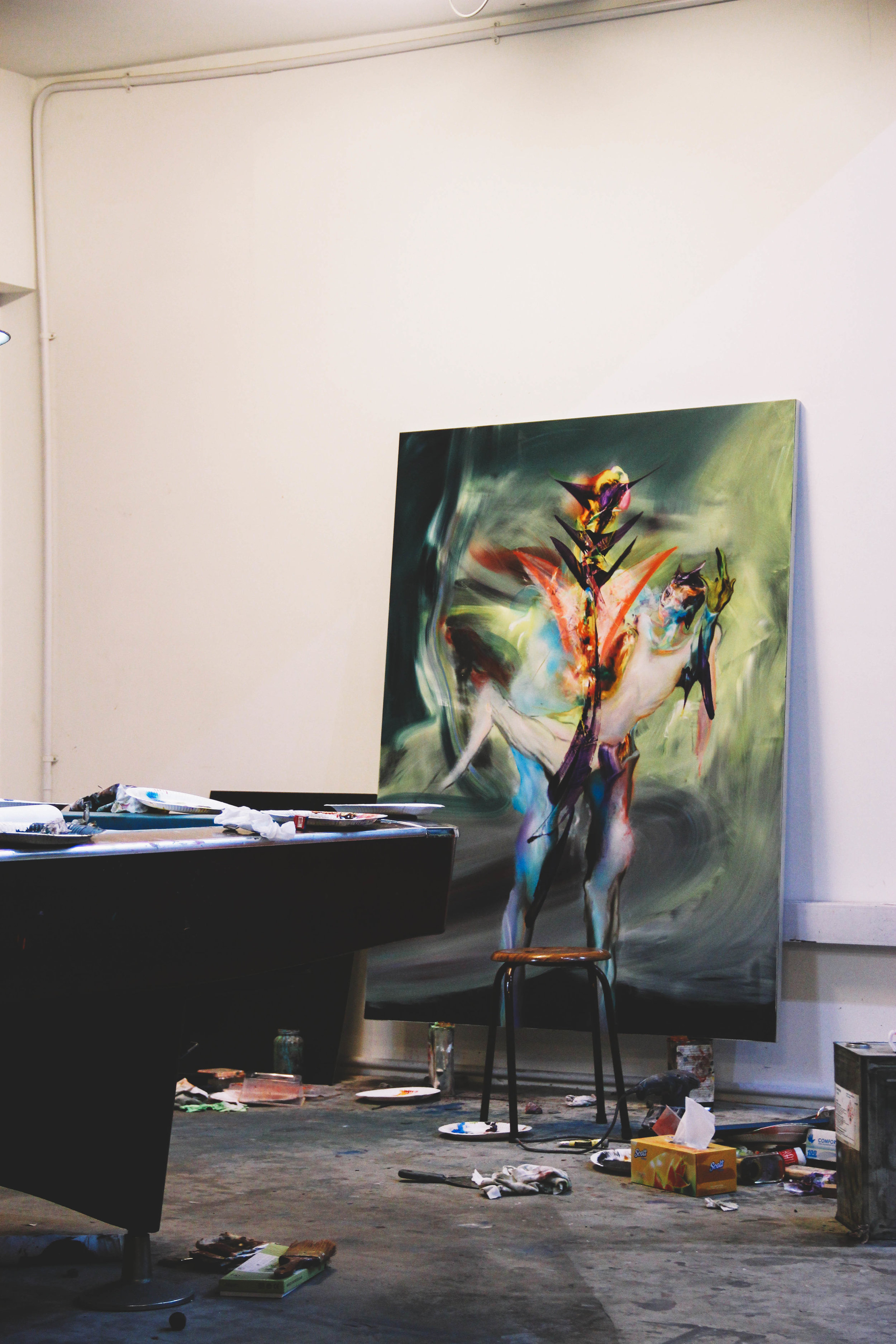
Photo Credit: SGABF
There is also that sensation of instinct, of something opening up; satisfaction. I try not to make satisfaction such a big deal, and I ignore it because what gives you satisfaction will change over time. So if I feel something behind my sternum and ribcage and it feels like opening up, and intellectually when it is quiet and you are not putting too much thought into it, when the voices of how you are going to spin the narratives go away, and there is not too much judgement and opinion, that is when you know it is done. Sometimes you might not know, so you use maps. You compare to your heroes or your sketches - things that help to guide yourself through painting. I'd like to think I don't need that and I can just create in the dark, like in the biblical story; first, everything was created, then [God] turns on the light.
What I do not like about painting is the slowness. I wish it could be as quick as thought, just bang, bang, bang! and you get the colours. But sometimes that is where you get the satisfaction — as much as I do not like the idea of satisfaction. It is this feeling you get that you earned every bit of it; you spent time. I like to think that I pull ideas out of thin air, but I actually spend a lot more time thinking up ideas about what to do, and less time conceptualising. That is done when you are not really thinking about it.
SGABF: Artists often face the eternal struggle of making art and surviving as a full-time artist. What is your opinion on that general culture of the arts?
RP: I think these days less so than throughout the course of art history. There are some things that you do not get to do that you probably could get away with in the past, like manifestos where you generalise the population of a world that you have never seen before and assume that you are the first to do it. Now, you have access to more information about what is going on and where, and people are more self-conscious. There is a hyperconsciousness of what else is going on in the postmodern world.
In terms of the struggle, it sounds like a financial one. I was told that Hieronymous Bosch was a hobby painter and Edvard Munch gave up being a full-time artist and did wall murals and stuff like that. So maybe what we have now are blessings that we do not really count. In the past, you can pick up a job and that is it for the rest of your life and five generations down; you are that, and you are defined by that. These days we have more access and flexibility; you can practice it, although you probably cannot make a living out of it. But anyone who decides to be an artist probably already knows that, right?
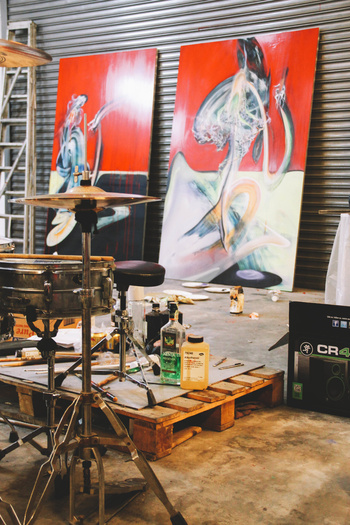
RP: As a painter, where does the self exist visually? Depending on who is talking about your work, the thing that you hold dear can be dismissed or praised. On one hand, I wanted to fully embrace that I could be a stylemonger. On the other hand, I can just play and see what happens — which is experimentation. After a bunch of experiments, you always hit a point where, Bingo! you get your masterpiece. In a sense, the style that I have developed was also something that I experimented on and found the right combination to, and I knew that it is precious and good. It came together in the right proportions, and I could exploit it perhaps to an unlimited amount.
There is nothing that you can do to prevent yourself from being a narcissist if you have the intention to be one, no matter how much you rationalise about not being one. The title "Swallow Shadow" just sounds better on paper than "Swallow Ego". But with a title, you are usually not selling a product, you are selling an idea.

Photo Credit: SGABF
SGABF: One of your exhibitions, Swallow Shadow, was explained as "the swallowing of your own ego in order to create something that is honest and true." Is this in reference to Freud’s concept of letting one’s subconscious mind take over instead? Is that an important part of your practice?
RP: As a painter, where does the self exist visually? Depending on who is talking about your work, the thing that you hold dear can be dismissed or praised. On one hand, I wanted to fully embrace that I could be a stylemonger. On the other hand, I can just play and see what happens — which is experimentation. After a bunch of experiments, you always hit a point where, Bingo! you get your masterpiece. In a sense, the style that I have developed was also something that I experimented on and found the right combination to, and I knew that it is precious and good. It came together in the right proportions, and I could exploit it perhaps to an unlimited amount.
There is nothing that you can do to prevent yourself from being a narcissist if you have the intention to be one, no matter how much you rationalise about not being one. The title "Swallow Shadow" just sounds better on paper than "Swallow Ego". But with a title, you are usually not selling a product, you are selling an idea.
SGABF: You have received a lot of attention in many different countries; Italy, Israel, Australia, Switzerland, and here in Singapore, with a recent exhibition at Chan + Hori Gallery that saw nearly all 17 of your works sold over a weekend. As an artist, what is your idea of success?
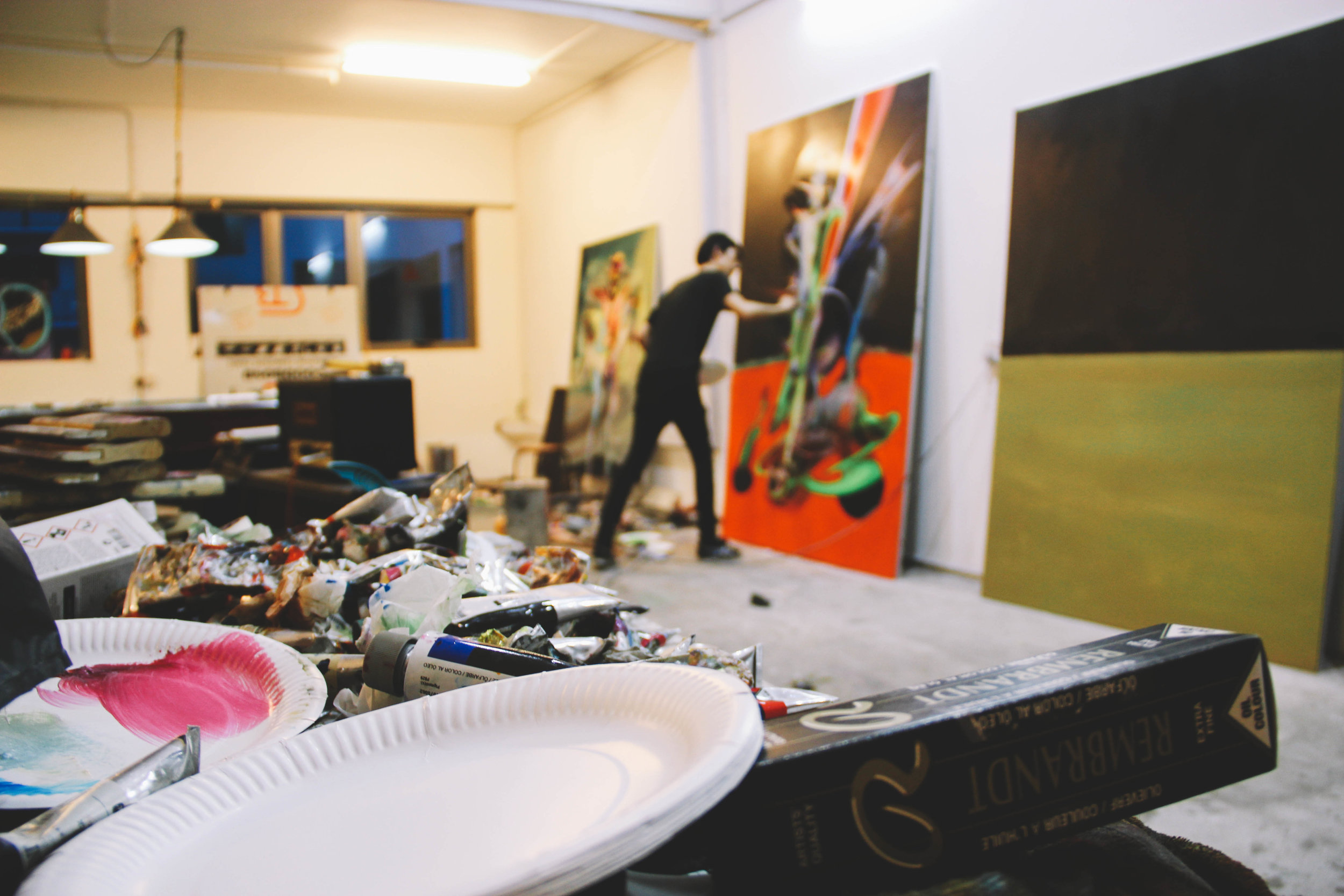
Photo Credit: SGABF
RP: It is easier to think about your worst fear than what you think is a success. I do not look forward to a day when I would wake up and wish that I was still asleep, and think that it is just a dread to get by. I am usually happiest at the end of the day when I have expended my energy. I would have felt like I have put it in good places, whether it is successful revenge or productive wholesomeness. If you can sleep well and you do not have a desire for things that are out of your control or if you can let go of those things, that is a sign of success. If you are financially stable and you have got things that fulfil your emotional bank account, and you have good thoughts before falling asleep, and what keeps you up at night is coffee as opposed to guilt, ambition or jealousy, that is a nice thing to have. That is very important to me.
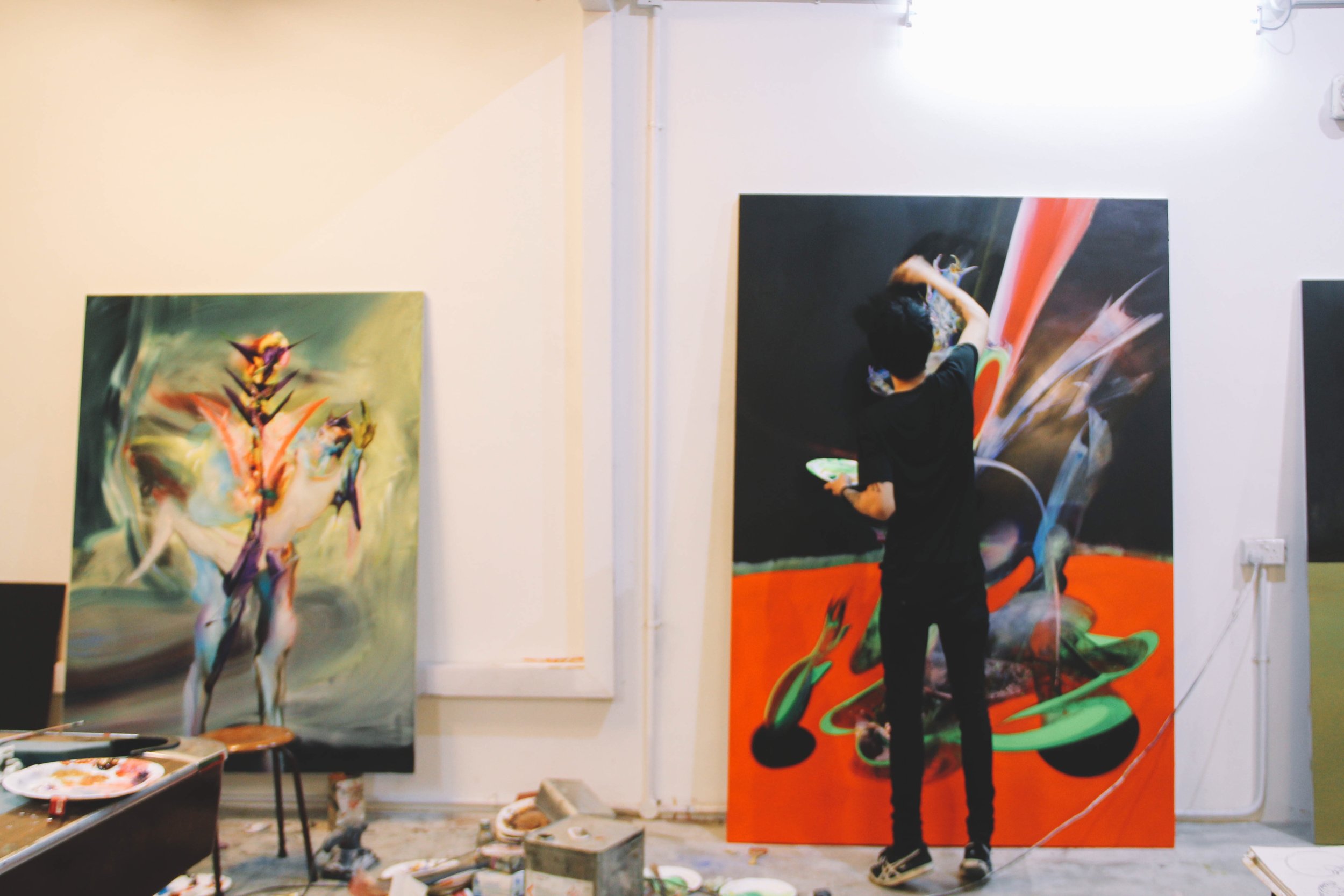
Photo Credit: SGABF
If you ask me what is a successful painting, I cannot give you a proper definition. But to me, a successful painting is part man, part bear, part pig. I like this idea, where you describe a painting to be part impressive, part accidental, and part I-don’t-know-what-is-going-on.
Ruben Pang's vibrant and ethereal work combines fluid technique with a kaleidoscopic palette. Without a preconceived image of the final composition, Pang's artistic practice evolves throughout the painting process, removing the boundary between abstraction and representation. Using oil paint and alkyd resin, Pang paints, scratches and erases his painting using brushes, hands, palette knives and sandpaper, revealing layers of colour that reflect projections of his psyche. Pang works on aluminium panels, which allows him greater freedom to transform the image as it develops. His work explores medium and method, creating a feeling of dynamism while testing the boundaries of colour, form, and transparency.
His recent international shows include a solo exhibition, The Glass Eye Opens with Noosa Regional Gallery, Aetheric Portraiture with Primae Noctis Art Gallery in Lugano, Switzerland and a group exhibition, Deep SEAwith Primo Marella Gallery in Milan, Italy. Locally, he has exhibited and performed in the Singapore Art Museum, Lasalle College of the Art's Praxis and Project Space, The Substation, and Chan Hampe Galleries. After graduating from the Lasalle College of the Arts in 2010 with a Diploma in Fine Art, he received the Winston Oh Travelogue Award (2010), the Georgette Chen Arts Scholarship (2009-2010), the Lasalle Award for Academic Excellence, and was a finalist in the Sovereign Asian Art Prize in 2010 and 2011.
www.rubenpangstudio.com
© Singapore Art Book Fair 2025. All rights reserved.
For further enquiries, please contact us at info@singaporeartbookfair.org.
Singapore Art Book Fair is organised by
![]()
For further enquiries, please contact us at info@singaporeartbookfair.org.
Singapore Art Book Fair is organised by

